Key Insights
- Ether, the asset, experienced a strong bounce back from Q2 lows, but Ethereum the network struggled to regain the same level of transaction volume, fee revenue, total value locked, or user activity from prior to the May sell-off. Behind the scenes, the picture was brighter as Ethereum continues to dominate smart contract network developer share.
- User activity did pick up on Layer-2 as Ethereum’s rollup-centric roadmap seems to be slowly materializing. Total value locked on both Optimism and Arbitrum reached $1 billion.
- A successful transition to Proof-of-Stake just prior to the release of this report set up a new era for Ethereum. With a 99% reduction in energy usage, a potentially deflationary underlying currency, and an investable yield, Ethereum may finally find some of the institutional adoption proponents have long clamored for.
A Primer on Ethereum
The Ethereum Blockchain network is a decentralized data storage and transaction validation platform. The breakthrough introduction of smart contracts and a virtual machine on the network, create a decentralized Turing-complete software solution. There are thousands of individual tokens and applications built on top of the Ethereum blockchain. The protocol gained broad recognition after developing a deep decentralized finance ecosystem and, more recently, many interesting Web3 use cases. The protocol made the transition to Proof-of-Stake from Proof-of-Work on September 15, 2022. Today, Ethereum is the world’s second-largest cryptocurrency by market capitalization.
Key Metrics

Performance Analysis
Quarter Highlights
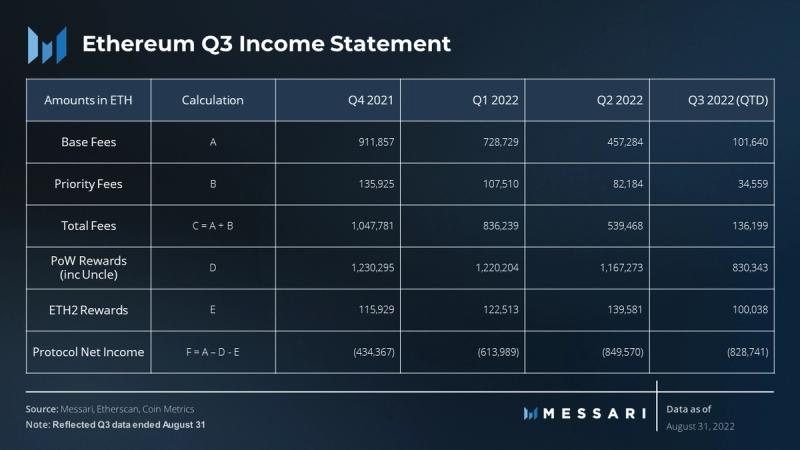
Crypto markets rebounded in Q3 2022, partially recovering from the Terra and macro-induced meltdown in Q2. Ether outperformed from a price perspective in anticipation of the changing tokenomics and users accumulating spot assets on the potential for airdrops stemming from The Merge. On September 15, Ethereum successfully executed its consensus change from Proof-of-Work (PoW) to Proof-of-Stake (PoS). This transition ushered in a new era for the largest smart contract platform. Post-Merge, daily block rewards declined from roughly ~13,500 ETH to ~2,000 ETH, which has greatly reduced the network’s security expense.
Active addresses and transactions have remained largely stable for Ethereum with relatively minor changes QoQ. While addresses and volumes may tick up with wider crypto adoption, Ethereum’s scaling will come from Layer-2 solutions rather than a more performant base layer.
The protocol’s revenue was brought down by the combination of another crypto bear market, increased volume on L2s, and the upgrades in protocol contracts for gas efficiency. Consequently, total fees fell off a cliff in Q3, dropping to their lowest levels since 2020. If these fees continue to fall into the back half of the year, they will directly impact the staking yields in a Post-Merge world.

Network Performance

Ethereum transaction count has remained largely range-bound since the implementation of EIP-1559 in August 2021. Post EIP-1559, the gas fee for the next block changes in the opposite direction whenever blocks are filled above or below the target limit. The new setup has effectively reduced the variance in the number of transactions per block by having the transaction fee absorb the variance.
Over the quarter, average daily transactions were 1.2 million, up 6% from the previous quarter. Growth was observed in ETH transfers and DeFi transactions growing 7% and 14% to 415,000 and 82,000 average daily transactions, respectively. On the other hand, NFT and bridge transactions declined. NFT transactions fell 17% over the quarter to 181,000 transactions per day, and bridge transactions fell by 41% to 9,000 transactions per day.
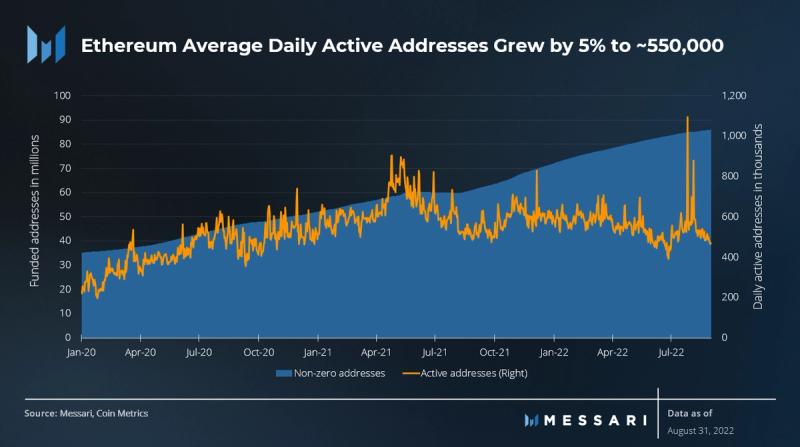
Active addresses naturally followed a similar pattern to transactions. There were 550,000 daily active addresses for the quarter, up 5% from the previous quarter. The growth was primarily due to a spike in active addresses on July 27, 2022, when Chandler Guo, a prominent Ethereum miner, announced plans for an Ethereum PoW fork, along with some wallet “maintenance activity” from Binance. Most importantly, the activity likely wasn’t due to a new influx of users or a novel application.
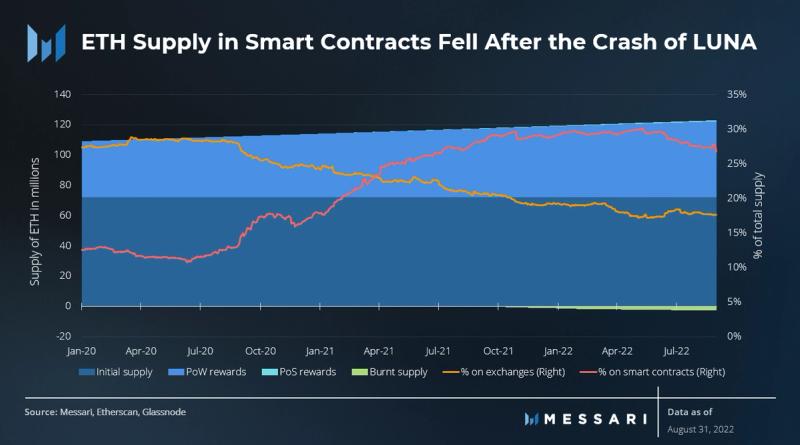
Over the period, Ethereum supply grew by 0.7%, or 4.2% annualized. All of the inflation came from PoW rewards as the burn from transaction base fees was slightly higher than the inflation from Beacon Chain rewards.
ETH in smart contracts has trended upwards since 2020 as the asset is increasingly used within DeFi and other applications. This has translated to a multi-year decrease in ETH held on centralized exchanges. However, the collapse of Terra seemed to have eroded trust in smart contracts even across ecosystems. The percentage of ETH in smart contracts peaked at 30% on May 9, 2022, the same day as Terra’s collapse, and has since trended downwards. ETH on smart contracts at the end of August stood at 27%, falling 2% from the end of June.
Market Metrics

Unsurprisingly, bullish bets by traders increased in Q3 as the timeline for The Merge was finalized. Since the official target block difficulty was set in mid-July, indicating a mid-September Merge date, call volume steadily increased across exchanges. Call volume at the end of August more than doubled the levels seen at the end of June.
The ratio of calls to puts also increased. The strike prices for these calls was largest at the $5,000 level for the September 30 expiry and $2,500 for the December 30 expiry. ETH hovered around $1,500 for the last few months when these bets would have been placed. The strike prices for these call volumes indicate many gamblers are targeting the September expiry (i.e., expecting ETH to more than triple) while the more fundamental investors are looking at the December contract.
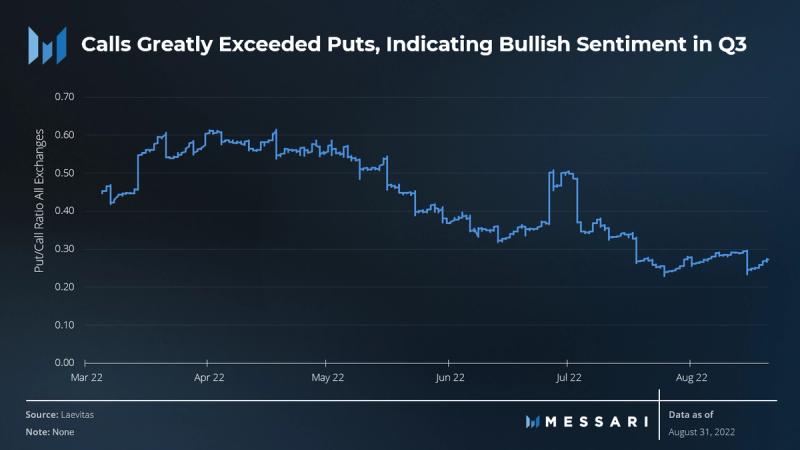
As sentiment shifted and the price of Ether slowly marched higher, volatility trended downwards. Ether had a much tighter range of daily moves throughout July and August. This decline in absolute volatility was seen across the crypto and equities markets after a very challenging Q2. Ethereum’s correlation to Bitcoin remained near 90% while the correlation to the S&P 500 trended down slightly.


Layer-2 Analysis
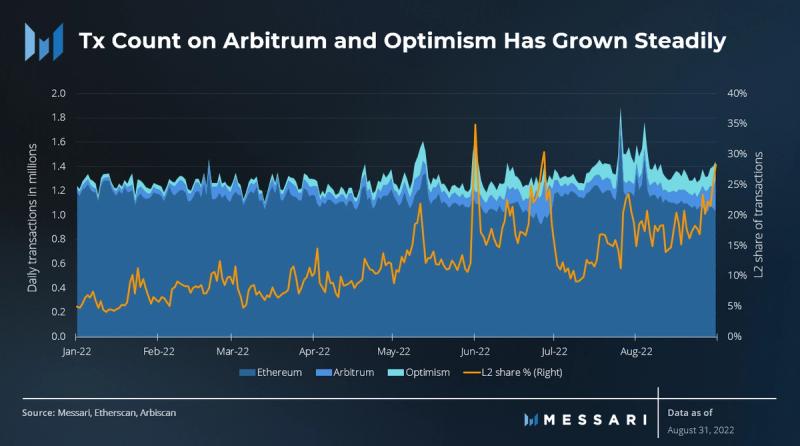
Ethereum’s rollup-centric scaling plan is finally materializing. While the average transaction count for Ethereum may have remained range bound, there was meaningful growth in L2 transactions. Average transactions on Arbitrum grew almost three times, from 39,000 in January 2022 to 115,000 in August 2022. Over the same period, transactions on Optimism also grew almost 3.5 times from 41,000 to 142,000.

Emerging underlying ecosystems are driving L2 activity. L2 applications have attracted real usage and attention, namely GMX on Arbitrum and Synthetix on Optimism. These applications are also among the biggest drivers for TVL on their respective platforms. However, some of this growth may be attributed to mercenary capital rather than organic users, as OP incentives went live and an Arbitrum airdrop is anticipated.

More catalysts for L2 growth and adoption are coming this year:
- Arbitrum’s Nitro upgrade recently went live with higher throughput and lower fees. With the upgrade locked in, Abitrum Odyssey is expected to resume again which will lead up to its token launch.
- Three different teams announced breakthroughs with zkEVMs: Polygon, zkSync, and Scroll. zkSync’s zkEVM is expected to launch its mainnet in Q4.
- StarkNet announced plans to decentralize and launch its own token.
These token launches with airdrops are important events for the ecosystem. They drive usage to the platforms and help create a community of user investors. However, they may ultimately be an unsustainable approach to adoption. Rather, these ecosystems need to create organic user adoption to thrive long term.
Sector Analysis
Decentralized Exchanges (DEXs)

In Q2, DEXs had an average of $2.78 billion in daily transaction volume. In Q3, this dropped to $1.83 billion. YoY volumes are also down to the tune of roughly $800 million. Uniswap dominance increased from 60% at the end of Q2 to 72% at the end of August. Uniswap remained consistently at ~75% of DEX market share throughout Q3. Notably, Curve’s volume share fell from 16% down to 8% despite continuing to issue higher incentives than the competition.
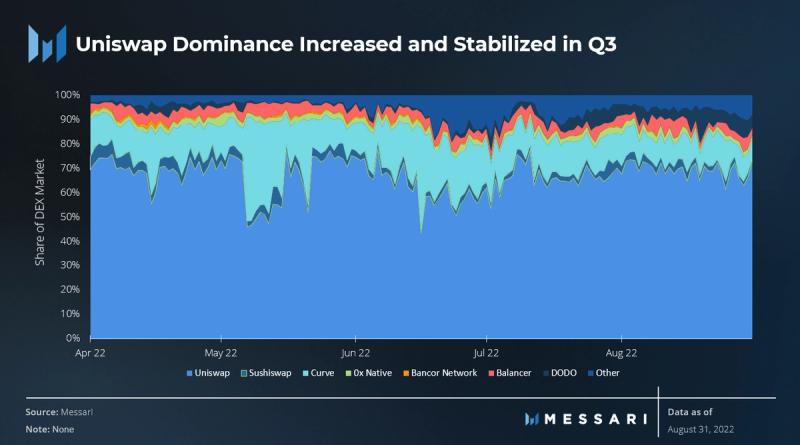
Borrowing and Lending
Average lending volumes declined sharply in Q3. The daily average fell from $280 billion per day in Q2 to $116 billion. July was a notably slow month before volumes picked up slightly in August, as demand for spot ETH increased for individuals looking to farm the ETH POW airdrop.

NFTs

While the average NFT daily trading volumes dropped dramatically, the average number of daily traders witnessed a much smaller decline. This indicates a sticky base of committed users at around 40,000 per day. Volume in dollar terms fell 90% from January. Sales have averaged less than $1 billion per month in Q3 compared to $4.6 billion in Q2. The decline is not only to do with a slowing market for NFTs but also the drop in ETH price which most NFTs use as their base currency. OpenSea continued to dominate market share in Q3.
Sudoswap launched in Q3. It provides a new take on the NFT marketplace by creating liquidity pools for NFTs similar to a Uniswap for NFTs. Although volumes seem to have peaked in August, sudoswap will be worth monitoring when (if) the NFT market downturn reverses.
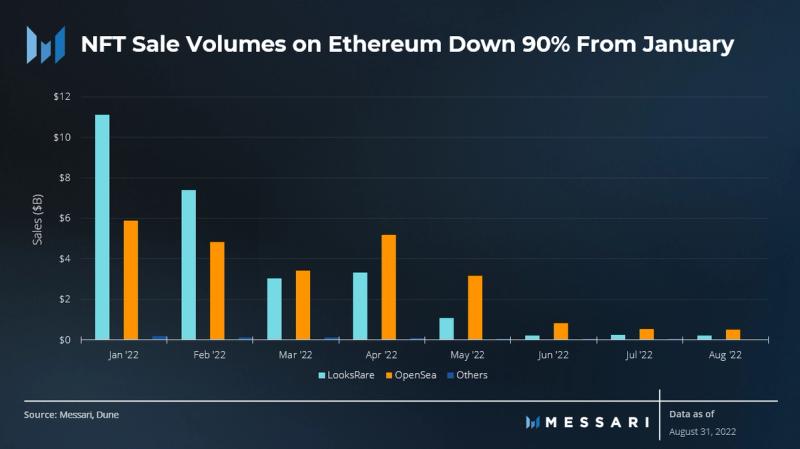
Stablecoins
Stablecoins are the liquidity for the decentralized finance ecosystem. Turning points in stablecoin velocity have followed the overall Ethereum market cap with a fairly tight correlation. While stablecoin movement and overall volumes were largely unchanged from Q2, there were numerous activities that were important to note for this segment that could have important implications for DeFi moving forward:
- Circle, the organization behind USDC, banned 38 addresses after the U.S. Office of Foreign Assets Control (OFAC) sanctioned the smart contracts of the privacy protocol Tornado Cash.
- Following this, MakerDAO’s DAI plans to lower its exposure to centralized stablecoins, and its founder Rune Christensen laid out a plan for its “Endgame.”
- Tribe DAO plans to unwind because of growing technical, financial, and regulatory risks, and all FEI will be redeemed.
- Circle also launched a euro-denominated stablecoin, EUROC. The Euro traded at ~1 US dollar.
- Aave announced its USD-stablecoin GHO.

Circle’s ban of Tornado Cash addresses was not well received. USDC market share fell from 44% to 41% over the quarter. The drop was largely absorbed by BUSD which increased its market share from 14% to 16%.
The Merge and Transition to Proof-of-Stake
After much fanfare, The Merge occurred successfully on September 15, 2022. Validator dropout and block failures were limited, and users and applications were unaffected. Miners created an ongoing Proof-of-Work fork called Ethereum Proof-of-Work (ETHW), which trades at ~1% of the Ethereum market cap in futures markets at the time of writing. The chain has seen no support from users and limited support from infrastructure providers. Coordination failures by the team launching the protocol seem to have doomed it from the start.
The Merge resulted in a decrease of 90% in block rewards. This significantly reduces the network’s inflation and reduces its annual security expense. Had Ethereum used PoS since the beginning of the quarter, it would have had a marginally net deflationary supply burning 1,600 more ETH than cumulative validator rewards. Simulating the effects of The Merge from the beginning of 2020, ETH would have been deflationary for almost the entire period since the implementation of EIP-1559 in August 2021.

The transition to PoS also allowed Ethereum to significantly lower energy consumption, down by 99.95%. The Merge should further alleviate ESG concerns over the use of Ethereum. This should open the gate for more organizations to adopt ETH as an investable asset or to use the network itself for operations. Earlier, prominent organizations like Mozilla, Discord, and Tesla have had to halt their blockchain adoption plans because of environmental concerns.
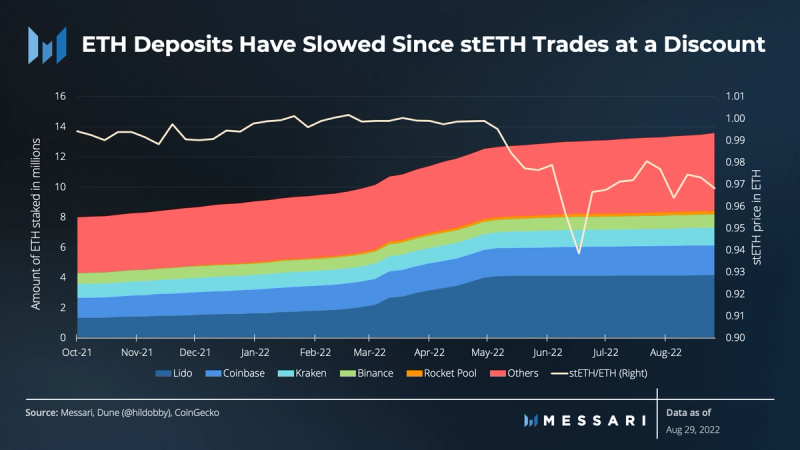
Inflows into the Beacon Chain slowed significantly over the two-month period, growing by only 4% compared to 17% for Q2. The primary reason for this low growth is that the largest staking derivative, stETH by Lido, currently trades at a discount to spot ETH. As long as the discount remains, users would profit more from getting staking exposure by buying stETH on the secondary market than staking directly on Ethereum. Among the large centralized staking providers, Coinbase and Binance grew by 4% each despite their staking derivatives cbETH and BETH also trading at discounts to ETH. Among liquid staking derivatives, Lido grew by 1% to 4.2 million ETH staked, and Rocket Pool by 11% to 218,000 ETH staked.
Competitive Analysis

Ethereum and its L2 ecosystem have a combined share of 62% of total crypto smart contract TVL. Ethereum contributes the lion’s share of the TVL with $34 billion, while Arbitrum and Optimism only contribute $1 billion each. Ethereum’s TVL has grown by just 8% since the end of Q2, but Arbitrum and Optimism had higher quarterly growth rates of 33% and 224%, respectively.
On a longer time horizon, Ethereum and its L2s’ share of TVL has fallen consistently since the beginning of 2021. Q2 2022 was the major exception when Terra’s crash led to an increase of 8% in Ethereum and L2 share.
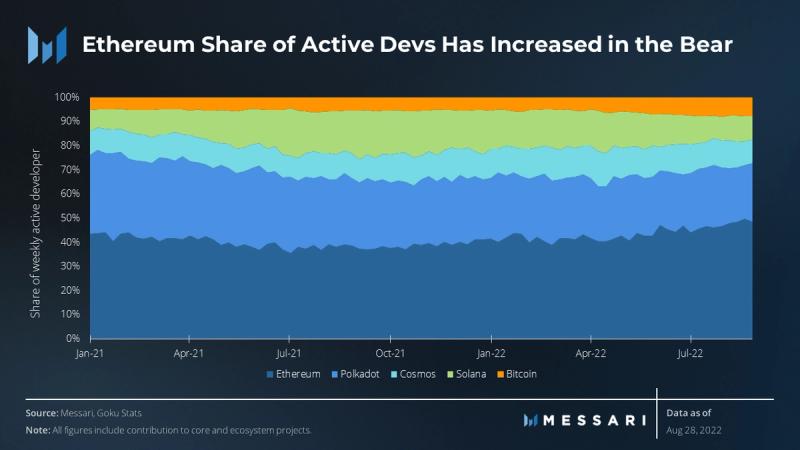
The Ethereum ecosystem has a key moat in its thriving developer scene and the dominance of its virtual machine throughout crypto. Its ecosystem has almost the same number of weekly active developers as the next four largest ecosystems combined. In the bear market, development activity on Ethereum has stood up better than on other ecosystems, its share has increased by 10% compared to last year.
Qualitative Analysis
Regulation
While regulation is always a potential concern in the crypto industry, Q3 has been more action-packed than usual. Responses from U.S. government agencies on Biden’s executive order outlining each agency’s approach to “addressing the risks and harnessing the potential benefits of digital assets and their underlying technology” were due in early September. Many agencies did not meet this deadline, and instead, the big news of the quarter was the US Office of Foreign Assets Control (OFAC) sanctioning the smart contracts of the privacy protocol Tornado Cash. The action made it illegal for any U.S. citizen to interact with the protocol. This is the first time OFAC has sanctioned any entity outside of an individual.

This decision set off a wave of censorship of Tornado Cash addresses from key infrastructure providers like Infura and Alchemy. This incident prompted broader discussion in the Ethereum community about true decentralization. Users running their own nodes can still access Tornado Cash, but the vast majority rely on third-party infrastructure providers to access the blockchain. Simply put, if the most popular wallets do not allow users to interact with a certain smart contract, that protocol becomes largely inaccessible for most users. Lido, Coinbase, Kraken and others seem to be complying with OFAC, making up over 66% of the current validator set.
If the implications of this decision were to go a step further, stablecoin operators like Circle (USDC) could fall under government regulation, similar to banking institutions, and a simple order by regulators could require these operators to ban a subset of addresses. This situation would essentially put DeFi under direct government authority. USDC regulation is a particular concern for Maker, whose stablecoin DAI is backed by roughly 30% USDC. Maker is considering alternatives to USDC including ETH.
Sanctioning a smart contract has major implications for DeFi and crypto at large. There are immediate concerns of government overreach with this decision. One of the key tenets of a democracy is a right to due process, how can a smart contract have a day in court? How would it defend itself? Can any technology be banned by the government based on the precedent set by this decision? These are broad legal questions that will be adjudicated at the highest levels of the US courts in the coming months and years. Coinbase kicked off the opening salvo of this next chapter, by financially backing six users accused of interacting with the sanctioned Tornado Cash addresses.
Next Steps on the Roadmap
After completing a major step on the Ethereum roadmap, developers can focus all of their attention to scaling the network towards global adoption. Developers are now looking to the Shanghai upgrade which promises multiple improvements to the protocol. Most importantly, Shanghai will enable withdrawals for stakers.
Another proposal that will likely be included in the Shanghai upgrade is EIP-4844. This proposal will consistently make it orders of magnitude cheaper for L2s to post their transactions to Ethereum L1, bringing a more consistently cheaper Ethereum experience for all users. EIP-4444 may also be included in Shanghai. It would enable nodes to prune the transaction history after one year. The logic here is the challenge period for these transactions has long since passed and not requiring nodes to download this set of history will drastically reduce node resource requirements. As a result, the more accessible hardware requirements would enable more individuals to run nodes and further decentralize the network.
Towards the end of 2023 into 2024, Ethereum is expected to further scale with danksharding, an interim step prior to implementing data sharding. With the increased volume of L2 solutions, EIP-4844, and danksharding, Ethereum will likely be fast and cheap enough for 99% of users in the next 12–18 months.
Longer-term upgrades like enshrined rollups, statelessness, node pruning, and enshrined Proposal–Builder Separation, are not expected until the end of 2024 and beyond.
Closing Summary
Despite the crypto bear market, Ethereum remains the most vibrant ecosystem in all of crypto, with the majority of developer, user, and application activity. A successful transition to PoS should only help serve as a tailwind to further interest in the protocol. With new L1 challengers, Aptos, Sui, and Celestia launching in Q4, Ethereum will have to continue to build its moat and expedite its roadmap to remain the top dog in the smart contract space.



















